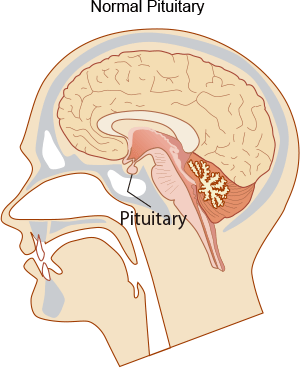- HOME
- For Patients
- Pituitary adenoma
Pituitary adenoma
- About pituitary adenoma
- Symptom of pituitary adenoma
- Diagnosis of pituitary adenoma
- Treatment of Pituitary Adenomas
About pituitary adenoma

If a mouse is carried on a picture, it will change to an expansion picture.
The pituitary, which is central to the hormonal system, sits within a depression in a bone called the "sella turcica" that lies behind the nose and between the eyes. It produces hormones that maintain the body's overall balance, including growth hormone, which is necessary for a baby to grow, and gonadotropin, which controls the menstrual cycle, and sends these hormones to organs throughout the body. Pituitary adenomas arise when some of the cells in the pituitary turn tumorous. Such adenomas are the third most common form of brain tumor, and are seen comparatively frequently in outpatient clinics. Pituitary adenomas can be divided into two major categories: hormone-producing adenomas (those that produce more hormones than normal) and non-hormone producing adenomas (those consisting of tumorous cells that do not produce excessive hormones). Around 40% of all pituitary adenomas consist of tumorous cells that do not produce excessive amounts of hormones. Of those that do produce more hormones than normal, around 30% produce a hormone called prolactin, which acts on the mammary glands to promote milk secretion, around 20% produce growth hormone, which is involved with growth of the body, and around 10% release other hormones.







